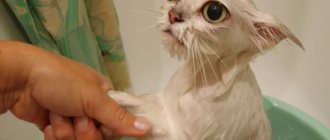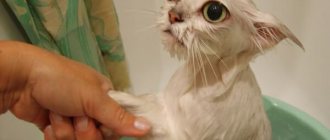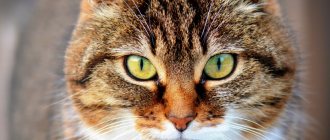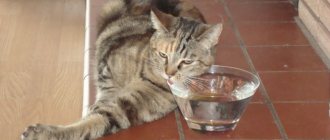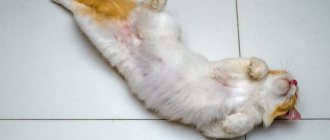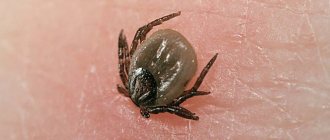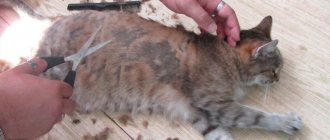Trembling in a pet is a signal that some processes are happening in the body. The trembling can be large or small and sometimes not entirely noticeable under a thick coat. You can feel this symptom if you put your hand on the cat.
There are many reasons why a cat trembles, but it is impossible not to notice it. Having noticed that your cat has chills or tremors in the body, you need to understand what caused this. This could be simple hypothermia, or it could be a more serious internal pathology.
It is worth remembering that it is impossible to do without the qualified assistance of a veterinary medicine doctor, since it is not possible to determine the exact cause of tremors in a cat.
Joyful emotions
Tremor in cats is sometimes a symptom of great joy.
For example, an animal missed its owner for a long time, being alone at home, and when it lies on his lap, it trembles. Separately, it is worth considering cases when the pet begins to shake in its sleep. Most likely, he is dreaming of some fascinating or emotional plot. To stop the trembling, simply wake up the animal. Another manifestation of trembling is sexual arousal. A mature animal, during a period suitable for reproduction, can become so overexcited that it manifests itself in the form of a tremor. Such emotional stress is very high, so it is worth giving the animal to satisfy its sexual instinct. If you do not plan to breed cats, you need to subject it to the procedure of castration or sterilization. You should not use special drugs to extinguish instincts, as they can provoke the development of serious and even fatal problems.
Sterilization is a very important stage in the life of every cat and, of course, its owners. At this time, your pet needs to be given as much attention and care as possible. Most often, the operation goes away without a trace and within a couple of days the pet returns to a full life. However, there are exceptions and the cat behaves strangely, to put it mildly... Increased body temperature, rapid breathing, inflammation of the suture - these are not all the symptoms of the unfavorable condition of the cat after the sterilization procedure. There is another one that very often scares cat owners. What does such a symptom as trembling indicate and whether it is necessary to sound the alarm, we will discuss further.
The cat is happy
Reason for joy is another reason for trembling in cats. Having met the owner after a long separation, a happy pet can be under the influence of the “hormone of happiness” for a long time, which is released into the animal’s blood.
Felines have a strong bond with their owners.
The fact is that cats are sensitive animals, capable of developing strong and long-lasting attachments to their beloved owner. Many of them experience separation painfully, which can cause a strong emotional outburst when they meet. Thus, positive emotions can also cause tremors in an animal.
IMPORTANT: if your pet has a hard time with long separation, try to minimize stress for the animal and do not leave it alone for a long time.
The cat's paws are shaking
Trembling paws means a lack of calcium in the body. To cure your cat, start giving him vitamin complexes with microelements. Typically, such courses last 10 days.
Kidney diseases can also cause trembling in the paws. In this case, give the cat the drug “Cat Erwin”. This medicine is made from natural ingredients and is absolutely harmless to animals. It will relieve inflammation and have a diuretic effect.
Trembling limbs can be a symptom of a serious illness, for example, rhinotracheitis. In this case, you need to contact a veterinarian.
But it is better not to self-medicate, but to immediately contact a veterinarian.
Strange behavior of a pet is always alarming. For example, a cat is trembling for no apparent reason .
An attentive owner will always notice if something is wrong with his pet.
In fact, trembling in cats
is not always a sign of illness and is not entirely without cause.
Very often the cat trembles all over
from overexcitement. The impetus for such excitement can be a game, hunting or sexual instincts - a bird outside the window, a potential partner or enemy, the desire to deftly catch a toy - and now the animal’s muscles cramp from pent-up tension.
If the cat's paws are shaking
in a dream - an uncomfortable position, excitement in a dream, however, if the same symptom is constantly present, we can talk about neurological causes.
The cat is shaking as if he is cold
- this can actually happen if the animal is cold - for example, after bathing.
For no apparent reason, the cat hid under the sofa and is trembling
. Probably something scared him in your absence, or it was the result of a blow, a bruise - an unsuccessful jump from a cabinet, for example.
Before drawing any conclusions, you need to observe your pet - at what moments does the cat tremble?
what is the tremor interval, intensity, how the animal tolerates it. The noticed symptoms will be the starting point for the doctor when making a diagnosis if the cat’s trembling is caused by a disease.
Why is the kitten trembling?!
Young kitten trembling
(if we exclude health pathologies) during puberty, a male cat during estrus and rutting.
In this case, it is better to sterilize the animal that is not intended for breeding. To understand why a kitten is trembling
, you need to observe him, finding out the cause-and-effect relationship of the tremor.
The reason why the cat is shaking,
There may be vitamin deficiency, often a deficiency of B vitamins. It is replenished with nutritional supplements or injections.
But not everything is so rosy. Tremor in cats can be a symptom of an underlying disease. Diseases that cause trembling in cats
:
- weakness, pain;
- TBI or its consequences;
- genetic developmental defects (vestibular apparatus disorders, cerebellar anomalies, etc.);
- neurological causes (degenerative and neuromuscular pathologies);
- problems with metabolic processes in the body;
- spinal injuries (possibly hidden, compression);
- poisoning in a cat;
- overheating (heat stroke), etc.
In order not to further injure a frightened or sick animal, it is worth inviting a specialist to your home. Examination, simple tests, necessary primary care - this is what can be done at home.
Sterilization is a very important stage in the life of every cat and, of course, its owners. At this time, your pet needs to be given as much attention and care as possible. Most often, the operation goes away without a trace and within a couple of days the pet returns to a full life. However, there are exceptions and the cat behaves strangely, to put it mildly... Increased body temperature, rapid breathing, inflammation of the suture - these are not all the symptoms of the unfavorable condition of the cat after the sterilization procedure. There is another one that very often scares cat owners. What does such a symptom as trembling indicate and whether it is necessary to sound the alarm, we will discuss further.
Pathological causes
Paws tremble most often when the cat’s body is infected with the herpes virus or when loryngotrocheitis develops. The main symptoms of such pathologies, in addition to the fact that the cat’s hind legs are trembling, are
:
- nasal discharge;
- cough;
- temperature increase;
- lethargy.
Trembling in the paws may also occur due to advanced helminthiasis or cystitis. In such a situation, paw trembling is aimed at relieving discomfort in the abdominal cavity. Treatment for the appearance of pathological tremors should be carried out urgently. Postponing it for days, and moreover, for a month, is unacceptable, as this may pose a threat to the life of the pet. The help of a veterinarian will be necessary.
An attentive owner of a mustachioed, striped, and perhaps completely hairless meowing pet (we are talking about) will definitely notice the changes that are happening to his animal. But how to react to them? Should you always bother your veterinarian? Or perhaps the symptoms that frighten us are not some kind of terrible pathology?
Today we invite you to talk about why a cat or cat may tremble, what diseases such trembling can be a symptom of, and how to help an animal in this situation
…
Cucumbers and cats
Many people are still interested in knowing why cats are afraid of cucumbers. Now let's try to understand this issue. Nowadays you can see many videos where the owner puts a cucumber next to the cat, and she gets scared of it. Why is this happening? Most likely, if a person gives the pet some other unknown object or vegetable, the reaction will be the same. The thing is that the animal simply did not expect to see a cucumber in this place. After all, the cat regards the place where it eats as safe. That's why she's calm and relaxed here. The appearance of a long, green, incomprehensible object at a very close distance is perceived as a threat. Also in appearance this vegetable resembles a snake. She is also the cat's worst enemy.
So, why are cats afraid of cucumbers? After analyzing the situation, zoologists came to the conclusion that such a reaction is natural for the animal. It’s just that cats are not used to cucumbers; they rarely come across them. If a green vegetable appears at the time of eating, that is, when the animal is completely relaxed, then this causes severe fear, which is manifested by a standard reaction - a sharp jump, flight or hissing.
The cat's paws are shaking
Trembling paws means a lack of calcium in the body. To cure your cat, start giving him vitamin complexes with microelements. Typically, such courses last 10 days.
Kidney diseases can also cause trembling in the paws. In this case, give the cat the drug “Cat Erwin”. This medicine is made from natural ingredients and is absolutely harmless to animals. It will relieve inflammation and have a diuretic effect.
Trembling limbs can be a symptom of a serious illness, for example, rhinotracheitis. In this case, you need to contact a veterinarian.
But it is better not to self-medicate, but to immediately contact a veterinarian.
Should I worry?
There is no point in raising a panic because an animal shook its head a couple of times or scratched its ear. But if you notice that the animal is constantly shaking its ears, or scratching them heavily, you need to contact a veterinarian, because some diseases can even lead to death in a cat. There can be many reasons for this behavior, as mentioned above; it is not always possible to figure out the problem at home on your own, and an erroneous diagnosis can lead to a worsening of the disease. That is why you need to entrust the examination to a qualified doctor.
After receiving the diagnosis, you can begin treatment, the methods of which can be chosen independently by the owner. Some people prefer medications, others prefer traditional methods, in any case, treatment should be carried out immediately.
Causes of pathological trembling
The reasons that lead to trembling in an animal are numerous.
These are both external factors (toxic substances) and internal diseases.
Trembling limbs
Trembling in the limbs of a pet can be caused by a herpes virus infection or rhinotracheitis of the animal. The main symptoms of this disease are purulent discharge from the nose and eyes, cough, vomiting, and fever.
Trembling of the limbs can be caused by worms or cystitis; by shaking the limbs, the cat tries to reduce itching or pain when helminths are active or the discomfort that arises during urination.
Head shaking
Quite a few reasons can lead to systematic or periodic twitching of an animal’s head. Frequent twitching may be a sign of otodectosis or ear scabies. In addition to twitching, you can observe how the animal often scratches the affected ear, literally plunging its paw into the ear canal and injuring the tissue. At the same time, the cat may meow pitifully.
Systematic head twitching can be a sign of otitis media, while the cat’s ear hurts and she won’t let it be touched. Or it may be evidence of the formation of sulfur plugs.
Head twitching may indicate liver failure, acute disruption of the respiratory system and even the kidneys. If the functioning of internal organs is disrupted, the disease occurs with a characteristic clinical picture of a particular disorder. Tremor appears already at the stage of organ failure.
Encephalitis, the use of certain medications, vestibulopathy, cerebellar pathologies, and traumatic brain injuries can cause tremors and even seizures.
Trembling croup and generalized tremor
Lesions of the spine (compression fractures, tumors, deformation of intervertebral discs, spinal stenosis) can lead to weakness of the lower extremities and trembling when the animal tries to stand on its feet. With further development of the disease, paralysis occurs.
Weakness as a result of illness or pain can lead to trembling of the animal's limbs or general trembling. For example, a swallowed sharp object, damaging the stomach or intestines, can cause the animal to meow pitifully, arch its back and tremble.
Neuromuscular diseases, degenerative neurological pathologies, myelin deficiency, metabolic pathologies and even poisoning by toxins (for example, organophosphates) can cause severe tremors throughout the animal's body.
Associated symptoms
The red cat is trembling, why?
Let's take a closer look.
Subclinical form of panleukopenia
In the subclinical form of panleukopenia, the cat develops lethargy and fever.
- The subclinical form of panleukopenia often does not manifest itself with pronounced symptoms, so timely diagnosis is especially important.
- The latent period of this disease lasts about ten days, then lethargy and fever appear.
- The cat refuses food and water and is very thirsty.
- Vomiting, diarrhea, and bloating are possible.
Hidden period of rhinotracheitis
Apathy and loss of appetite appear in a cat with rhinotracheitis.
- The first signs are apathy, loss of appetite, and fever.
- Serum nasal and eye discharge.
- Over time, they turn into purulent mucous discharge and increased salivation.
- Ulcers develop on the tongue, and parenchymal keratitis occurs.
Calcivirus infection
Calcivirus infection can be expressed by discharge from the eyes.
- In healthy and strong animals, it can occur in a latent form and manifest itself only as a slight tremor.
- However, when it develops into a chronic stage, it causes irreparable harm to the pet’s body.
- It can be expressed by slight discharge from the nose and eyes, lameness, apathy, and lethargy.
- A slight fluctuation in the body’s protective function and the disease becomes acute.
- The danger is the rapid course of the acute form and the development of secondary pathologies.
In this case, an unfavorable and cautious prognosis is made.
Puberty of a cat
One of the reasons for trembling is puberty in a cat.
If this is a young animal, such a condition causes unreasonable fear and, as a result, stress.
Central nervous system disorders
With meningitis, depression will be present.
- With meningitis, depression, low blood pressure, and fever will be present. Severe, continuous vomiting may occur.
- Symptoms of myelitis may not appear immediately.
- The initial stage is characterized by constant attacks of anxiety.
- Then severe pain, aggression, and loss of coordination with partial paralysis occur.
- The animal is constantly trembling, there is hyperthermia, difficulty urinating and defecating.
- Neurosis manifests itself in the inappropriate behavior of an animal.
- This may be an unreasonable fear of familiar things and events - feeding, one’s own habitat, the owner.
- Fear of closed spaces or litter boxes.
- Aggressive behavior gives way to complete apathy.
- Prolonged licking of the fur until it is wet.
When cats can shake
After all, the most important thing in this situation is to be able to understand the reasons for the appearance of this symptom.
It is also important to understand at what point you should seek help. Advice!
Advice!
Observe your pet, do not leave her alone and monitor all changes occurring in her condition. If everything is in order, then after a while the trembling will pass.
Frozen
Cats are very warm-blooded animals and the optimal room temperature for them is about 20 degrees. All cats tremble even after the usual, not to mention any temperature changes.
As you know, body temperature decreases during sleep. The same thing happens while under anesthesia, that is, the cat may simply freeze, which will provoke trembling.
Advice!
The blanket is in the way
Some animals do not perceive any foreign objects on their bodies. One of these (foreign to the animal) things is the one that is worn after the sterilization procedure.
By trembling, the animal may try to remove the blanket and thereby relieve itself of discomfort.
Attention!
In this case, you can try to wait until the cat calms down or consult a veterinarian about removing the blanket for a short period of time
If the doctor approves this step, then it is important to ensure that the cat does not dirty or lick it in any way. At this time, you need to keep an eye on your pet.
As you already understand, short-term trembling that goes away over time is not dangerous. However, if the cat is shaking for a long time, then this sign signals problems
Important!
Trembling a day after surgery is a sure sign that there are some problems. Perhaps the symptom is caused by a fever, which was provoked by an inflammatory process that began in the body.
If the matter is really inflammation, then the following symptoms will indicate this:
- suture swelling;
- discharge of ichor, pus from the wound;
- the appearance of vomiting;
- apathy and indifference of the animal.
If trembling is accompanied by any of the above symptoms, you should definitely visit a veterinarian. Only after an examination will he be able to make a diagnosis and prescribe the necessary treatment.
Lack of vitamins
Convulsions and tremors can be caused by a lack of vitamins in the body, namely magnesium, calcium or vitamin B. Usually, improvements occur after the missing vitamins are added to the pet’s diet. The required course is about 10 days.
Interesting!
Veterinarians advise adding brewer's yeast to your pet's diet in order to provide her with the necessary amount of vitamin B. Consult your doctor about this step.
If this phenomenon occurs quite often, it is necessary to determine the room temperature. If the room temperature is not comfortable for the pet, measures should be taken to provide warmth to the pet. The measure consists of raising the room temperature or providing the animal with warm bedding and eliminating drafts.
It is necessary to provide cats with warm bedding.
The cat hides its nose if it is cold.
Symptomatic treatment
Physiological tremors do not require treatment. Such trembling does not cause severe discomfort to the cat. He does not lose his appetite, does not become lethargic, and his mood does not deteriorate. To help a cat, you need to keep it in microclimatic conditions that are comfortable for it, devote time to it, and then the pet will tremble only with joy.
Often people try to eliminate tremors with drugs that are intended for humans. For example, they give him strong sedatives and antispasmodics. Such self-medication is unacceptable! Firstly, the animal's condition can become much worse. Secondly, the clinical picture can be blurred if the tremors are caused by some kind of disease. Thirdly, you can incorrectly calculate the dosage, give a medicine that the cat’s body cannot tolerate, and thereby further aggravate the situation (general intoxication is added to the disease).
If the trembling does not go away and new symptoms appear, then the best solution is to show the cat to a veterinarian.
If the trembling recurs regularly or there are any other alarming signs, you should definitely show your pet to a doctor. He will prescribe competent treatment. In some cases, it is enough for the cat to minimize activity for a while and give a mild sedative, but serious therapy and even surgery may be required.
The cat is shaking
It is absolutely impossible to notice the appearance of tremors in a pet. Sometimes you can’t see it (small tremors), but if you just touch the cat’s body with your hand, it will be felt.
Trembling can also be severe, with it the limbs usually begin to twitch intensely, this is very noticeable in hairless breeds of cats, as well as smooth-haired ones. It is impossible to confuse such a symptom with others (for example, with a cramp). Many owners, seeing that their beloved cat is trembling like a leaf, immediately, without finding out all the reasons, fall into a state of panic.
There is no need to panic, but this case should not be overlooked either. Before going to the nearest veterinary clinic, having previously placed the cat in a carrier, you should read the relevant information about tremors in cats, which can be found on many forums on the Internet.
The animal got scared
The second simplest explanation for trembling in an animal is intense fear. Such a tremor is invisible to the eye, but is felt as a small vibration in the pet’s body if you place your palm on it. In this case, it is worth finding out why the cat had this reaction. The reasons may be different:
- a change of scenery;
- the appearance of a new person in the house;
- presence of a foreign animal nearby;
- new item;
- unfamiliar smell.
Cats are frightened by situations they have never encountered. It is advisable to carefully introduce the animal to something new so as not to shock it.
Main reasons
Fear or extreme fright
A common reason why a cat shakes with small tremors. The animal shudders nervously, shakes its tail, and breathes rapidly due to the release of adrenaline, the fear hormone, into the blood. Due to tension, a tremor develops, which goes away as soon as the animal calms down.
If your pet is cold
Sometimes trembling in a cat occurs as a reaction of the body to hypothermia. When an animal is cold, it trembles in different ways, for example, small. In this case, it is impossible to visually notice the trembling, but if you put your hand on the body, you can feel how it vibrates. If a cat's chills are noticeable to the naked eye, then the cat is trembling violently. Often this condition is observed after washing the fur, when the animal’s body and head are wet, it actively shakes them, but cannot warm up because the room is not warm enough. Hypothermia often occurs when a cat walks outside for a long time in winter in severe frosts. Once inside the house, the pet winces, its muscles tremble, its legs and tail shake.
Stormy emotions
Trembling in an animal occurs at the moment of fright, while the cat arches its back and shakes its tail.
During overexcitation, you can also notice that the cat is trembling all over its body. This reaction can occur to both negative and positive emotions. If an animal senses danger, adrenaline, the fear hormone, enters its blood. When walking, the cat shakes its tail, its back is arched; if its nerves are at the limit, you can notice how the eye twitches.
Many owners note that a pet’s tremor occurs during games, affection, or a long-awaited meeting with the owner. If the kitten trembles after eating, this is also normal. Experts explain this phenomenon by the fact that when an animal eats its favorite food, many muscle groups contract due to positive emotions, which is why trembling appears.
Hormonal surges
Heat is a common reason why a female cat or tom will shiver. The cat's sexual desire is so strong that the animal during this period becomes unlike itself. It constantly yells, does not eat, follows on the heels of its owner, shakes its paws, tail, and shifts its hind legs. From overexcitation there is a tremor of the head and back, chills can bother you even in your sleep. If the owner does not plan to breed offspring, it is better to save the four-legged friend from such suffering by castrating or sterilizing him.
Trembling when a cat sleeps
Therefore, if cats sleep, involuntarily jerking their legs, head, tail, this is considered the norm, because at this moment the animal experiences certain emotions that contribute to the contraction of muscle tissue. But when the pet wakes up, everything goes away. Sometimes support is required from the owner so that the cat can calm down and forget about the nightmare.
Diseases
Trembling can be a symptom of a dangerous disease in which the animal is bothered by tremors and chills. If a kitten or an adult cat constantly experiences trembling throughout the body, the following diseases may be occurring in the body:
- Rhinotracheitis. An infectious pathology that affects the eyes and respiratory organs, and if treatment is not timely, the musculoskeletal system is involved in the pathological process. The animal's temperature rises, the kitten is vomiting due to severe intoxication, and is also worried about tremors and fever.
- Helminthiasis. They often cause a cat's hind legs to shake.
- Renal dysfunction. A dangerous pathology that negatively affects the functioning of internal organs and systems. If your pet is trembling even when lying down, and there are problems with urination, it is better not to hesitate to visit a doctor.
- Epilepsy. A serious and dangerous disease that can begin to bother the animal as early as 2-3 months. During an attack, the pet is unconscious. Due to involuntary muscle contractions, the cat shakes its tail and head, its paw may tremble, its eyes become glassy, and the animal is completely disoriented.
- Exhaustion of the body. This condition is often observed due to poor nutrition, after a serious illness, or after surgery. A lack of vitamins causes the cat to tremble, so if such a symptom is bothersome, the owner should review the diet and give the pet additional vitamin supplements.
How to prepare a cat for a bath, what should you prepare?
If there is no alternative to taking a bath, and the pet is afraid to wash, the owner’s first priority is to prepare the pet for the procedure in such a way as to minimize its stress. How to do it?
First of all, you need to try to ensure that the cat starts water procedures in the most relaxed state. The best way to calm an animal is through active games. A long chase for a fishing rod or ball will help your pet let off steam, but at the same time exhaust him, depriving him of the strength to resist.
Some cats find brushing soothing. This procedure will help kill two birds with one stone. It will put your pet in a calm mood, and at the same time it will allow you to get rid of tangles in the animal’s fur, which will interfere with washing.
It is impossible to know what is going on in the animal’s head, so even if the cat seems to have calmed down and prepared for a bath, its owner should protect himself. To do this, the pet’s claws are trimmed in advance. Easily excitable and aggressive animals, just in case, are placed in a special bathing bag that restricts movement (you can buy one at any large pet store).
In addition, before bathing your cat, you should prepare in advance:
- pet shampoo that corresponds to the type of pet’s fur and the task at hand (for example, for flea treatment);
- a washcloth for applying it;
- a small ladle to make it easier to wash away soap suds by pouring water on the animal from above;
- a wide towel to completely wrap your pet in after a bath;
- a rubber cap to protect the cat’s ears from water getting inside (you can buy it at a veterinary pharmacy, pet store, or make it yourself from scrap materials).
So that the animal does not get nervous because of the sound of pouring water, it is also worth drawing a bath for it in advance. To bathe your pet, it is convenient to use a deep basin of small diameter. A special mat is laid at the bottom, which will prevent the cat's paws from slipping on the wet surface and will help the animal feel calmer and more confident.
When to contact a veterinarian
If you have consistently analyzed each of the reasons described above, and, in your opinion, this is not why your cat is trembling, you should hurry up with a visit to the veterinarian. After all, there are a number of not so harmless reasons that can cause trembling in a cat. These include helminths, skin diseases, parasites on the skin, and lack of vitamins (especially calcium and vitamin B). Often, after examining the animal, which includes general tests, a visual examination, and if the veterinarian deems it necessary, an ultrasound scan of the internal organs, it will be possible to establish that the cause of the trembling is diseased kidneys (read more about urolithiasis in cats). At the same time, animal owners often notice that with the appearance of attacks of characteristic trembling, the animal’s behavior changes and it becomes aggressive.
Trembling as a symptom of illness
The likelihood of such a serious and dangerous disease as rhinotracheitis should not be discounted. The disease can affect both a kitten and an adult cat, regardless of the breed, and in addition to attacks of characteristic trembling, damage to the respiratory system and eyes can be observed (about eye diseases in cats).
In order not to miss any dangerous disease, you need to show your pet to a veterinarian. It’s better that your worst fears are not confirmed than that later you will regret the lost time...
Video about cats
Today we talked about the possible causes of tremors in cats. We hope that our publication will help you be more attentive to the health of your pets, and if such an incomprehensible symptom occurs, you will not be confused, but will know how to behave correctly.
Have you ever watched your cat tremble? How often do you take your animal to the vet? Share with us your stories, experiences and, of course, photos of your pets on the pages of our VKontakte group - My Pets.
We are waiting for your feedback and comments, join our VKontakte group!
Tags
British cat Scottish cat behind cats or a cat trembling or a cat to me a cat does Cats why is a cat trembling a cat's hand. why is a cat trembling cat parents KITTENS SCHOOL FOR PARENTS The cat is trembling The cat's reaction to If a cat or a good cat owner should The cat is cold for which the cat is drying the cat phenomenally initially you need to take care of it you need as much as possible you don't need it in case you need it first your pet needs should I pay and is it necessary?
sterilizationexcitementveterinaryhealthdomestic
Situations that do not cause concern
Tremor is not always the cause of the disease. There are a number of reasons when this phenomenon does not cause much concern.
shutterstock
Cold
The most common factor that causes trembling in an animal's body is cold. No one is immune from hypothermia - and cats are no exception. If she is cold, she can tremble in different ways: large (this can be seen with the naked eye) or small (it is easy to notice the trembling by placing your palm on the pet’s body).
Emotional excitement
The cause of your pet's periodic trembling can be certain emotional states. For example, severe fear, discomfort from the appearance of strangers in the house, aggression. The tremor in this case is explained by the tension engulfing the cat. The animal is like a stretched string that is about to snap, and this is why it begins to tremble.
Not only negative emotions can cause this condition. A cat experiencing bliss may also tremble periodically. Many owners notice that when they return from work in the evening and a bored cat rushes towards them, rubs against their legs and purrs contentedly, it literally shakes with joy. This is fine. You should not leave your pet alone for a long time if she is experiencing separation so hard.
Sex hormones
A very common reason for a cat to tremble is hormonal storms. They shock the animal's body when it needs mating. During such periods, the male frantically marks everything around him, screams heart-rendingly, demanding a bride, and suffers from a tremor that covers his entire body - from the ears to the tip of the tail.
shutterstock
The same goes for cats. During estrus, they also often tremble. It is better not to allow the animal to suffer in such a way. If kittens are not in your plans, sterilize your pet or at least buy pills that reduce libido.
"Sleepy" tremor
Sometimes owners notice that the cat trembles when it lies with its eyes closed. The tremor in this case is not constant. Rather, we can talk about periodic shuddering of the body or its individual parts (for example, paws).
There's no need to worry. If there are no other symptoms, such trembling only indicates that the animal is as relaxed as possible and receives true pleasure from rest. True, sometimes a cat trembles from a nightmare in which, for example, a huge dog is chasing it, or a coveted sausage has been taken away. It's not scary. The animal will wake up and everything will be fine. In extreme cases, you can wake him up.
Trembling as a warning sign
There are many different pathologies in which a cat trembles. The most common:
- Kidney dysfunction often becomes a provoking factor for tremors in a cat. They require mandatory medical intervention, otherwise the animal may develop chronic pathologies (for example, urolithiasis).
- Rhinotracheitis is a disease of the musculoskeletal system. It usually causes the limbs to twitch. If left untreated, it can be fatal.
- Epilepsy is a fairly serious disease that requires the help of a veterinarian. The cat's body trembles slightly in front of him. In addition, there are symptoms such as “glassy” eyes, increased salivation, as well as decreased appetite and apathy. If left untreated, your cat may become paralyzed.
- Parasite infestation is one of the most common causes of trembling in cats. Diseases in this group include, for example, toxoplasmosis and flea infestation. If the animal periodically jerks its head, most likely it is being pestered by ear mites.
- Otitis media or ear plugs also cause head twitching.
- Exhaustion of the body. If a cat is shaking with small tremors, she is not active, indifferent to games and other entertainment, perhaps she lacks nutrients, vitamins or beneficial microelements. A deficiency of B vitamins and calcium has a particularly detrimental effect on a pet’s health. Reviewing your diet can solve the problem. With normal nutrition, the cat will stop trembling.
shutterstock
In search of an answer to the question of why a cat trembles like a leaf, you should analyze all the factors and take a closer look at the pet. Are there other symptoms and, if so, what are they? Is the animal’s emotional state stable? does it want to “walk”; trembling occurs when the pet is sleeping or awake; etc.
All this is of great importance. If time passes and the situation does not normalize or there are accompanying alarming signs, the cat should be shown to a specialist as soon as possible.
Previous Question and answer 4 reasons why a kitten is breathing heavily - what to do Next Question and answer Why is the kitten trembling and shaking
Cold
Sometimes you can notice that the cat is trembling as if he is cold. It's worth thinking about the fact that maybe he really is cold. After all, tremors are not always caused by diseases. There are a number of other reasons that should not cause much concern.
No one is immune from hypothermia, including cats. If she is cold, she can shiver in different ways. For example, small. You can notice this only when you place your palm on your pet’s body. It is also possible that you will notice the trembling with the naked eye. She is considered large.
If we talk about the tremor itself, it shouldn’t cause much concern. But it is worth remembering that due to too low temperatures, the pet can simply get sick. For this reason, everything possible should be done so that she does not become hypothermic and does not tremble as a result. That is, it is worth heating the room where the cat is well, and putting on animal clothing, which is sold in special pet stores.
Why does a healthy animal tremble?
The causes of cat tremors are divided into physiological and pathological. Unlike the latter, the former are not dangerous to the health of the animal and do not require any special measures. These include emotional overexcitation, chills as a result of hypothermia, craving for the opposite sex during sexual intercourse, and eating after fasting.
Excitement (joy, fear, etc.)
If your pet is shaking slightly, he may be experiencing strong emotions. They can be both positive (joy) and negative (fear). Anything can cause an emotional outburst in a four-legged pet: a meeting with the owner after a long separation, a car ride, veterinary manipulations, a sharp sound, screaming, quarrels in the family, the appearance of a new animal or child in the house, etc.
Usually the cat’s emotional state normalizes on its own. However, in severe cases, it may be necessary to use sedative veterinary medications, which are recommended to be previously agreed upon with a veterinarian.
Chills as the body's reaction to hypothermia
If an adult cat or kitten is shaking, it is most likely just cold. It’s one thing when a pet is shaking because it’s very cold, but it’s quite another when the animal is hypothermic. In the first case, it is enough to warm the cat and observe its body temperature for some time. In the second, it may be necessary to warm up the four-legged pet from the inside using warm enemas, intravenous administration of heated solutions, steam inhalation, as well as the use of drugs that enhance and support cardiac activity.
You can understand that a cat is trembling slightly because he is cold by the following signs:
- cool skin;
- sleeping on a radiator - a frozen pet constantly lies near heating devices;
- dry nose;
- the desire to crawl under a blanket or warm blanket, while the cat sleeps with its head covered with its paws or hidden under the blanket.
Sexual arousal
During sexual heat, male cats' behavior changes. An animal experiencing sexual arousal often becomes aggressive, leaves marks all over the house, makes loud sounds to attract partners, and trembles all over its body. To calm your pet, you can give him a sedative based on natural ingredients (mint, plantain, motherwort), or a hormonal drug in the form of tablets, drops or suspension (for example, Gestrenol, Stop-intim, Sex Control). .
When using anti-sex drugs that contain hormones, it must be taken into account that violation of the instructions for their use can lead to disruption of the hormonal status of the animal, which can lead to the development of ovarian cysts, glandular hyperplasia and uterine cancer, hydro- and pyometra, diabetes, immune diseases systems.
If symptoms of sexual arousal cause significant inconvenience to the cat's owner and he does not intend to get offspring from her, it is better to castrate the animal.
Eating after fasting
A cat can go hungry for a variety of reasons. Starvation can be caused by a serious illness, an upcoming test or surgery, or the owner leaving him without food for an unexpected long absence from home. A very hungry kitten or adult animal pounces on food, eats greedily and trembles as it does so.
There is no need to give your pet a lot of food at once. Overeating will negatively affect his well-being and digestion. Quickly swallowed food may simply not have time to be digested, and the four-legged pet will begin to vomit and have diarrhea. After a long fast, the animal should be fed frequently and in small portions.
Description of trembling
The scientific term tremor is used to define shaking. Tremors are defined as rapid and rhythmic movements that are caused by muscle contractions. Trembling can be classified according to several criteria:
- in terms of speed, shaking can be fast and slow;
- by localization, tremor of the animal’s head, limbs, croup and generalized tremor are distinguished;
- By severity, it is customary to distinguish between mild tremor, which does not interfere with the animal’s eating, drinking and leading an active lifestyle, and severe, in which case independent movement and eating are difficult for the cat.
The shaking may occur when you are at rest (resting tremor) and disappear when you move or try to make a precise movement. Limbs may tremble when the animal tries to hold them in a certain position.

